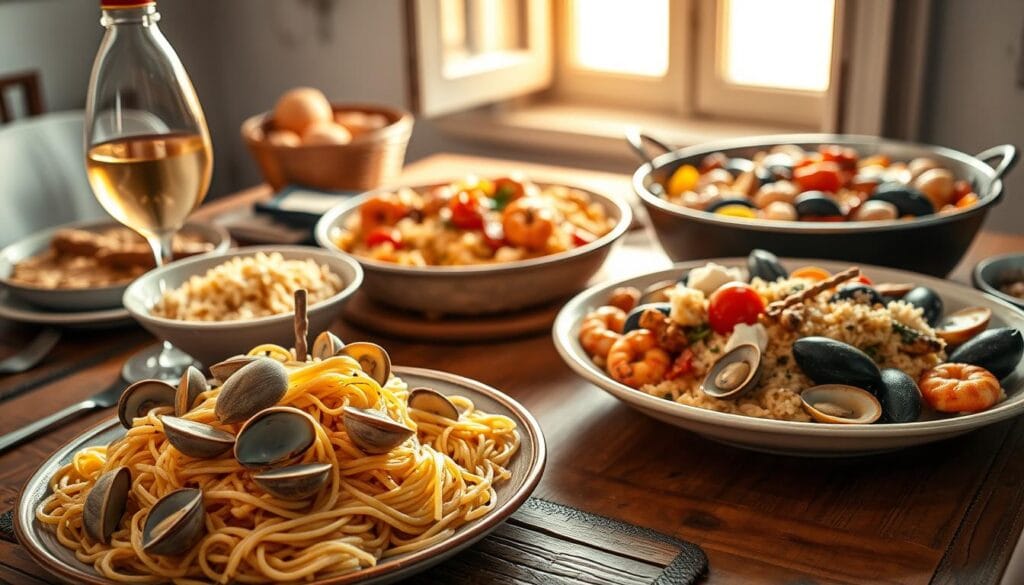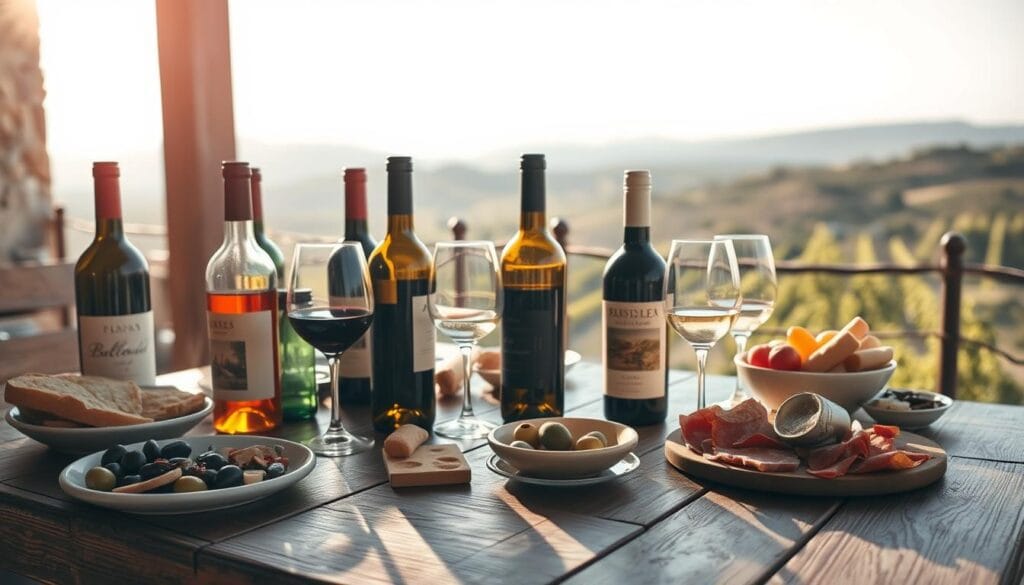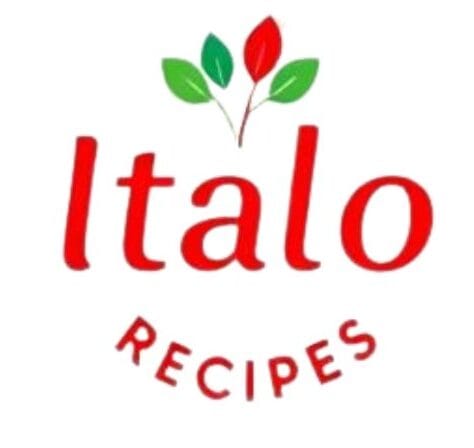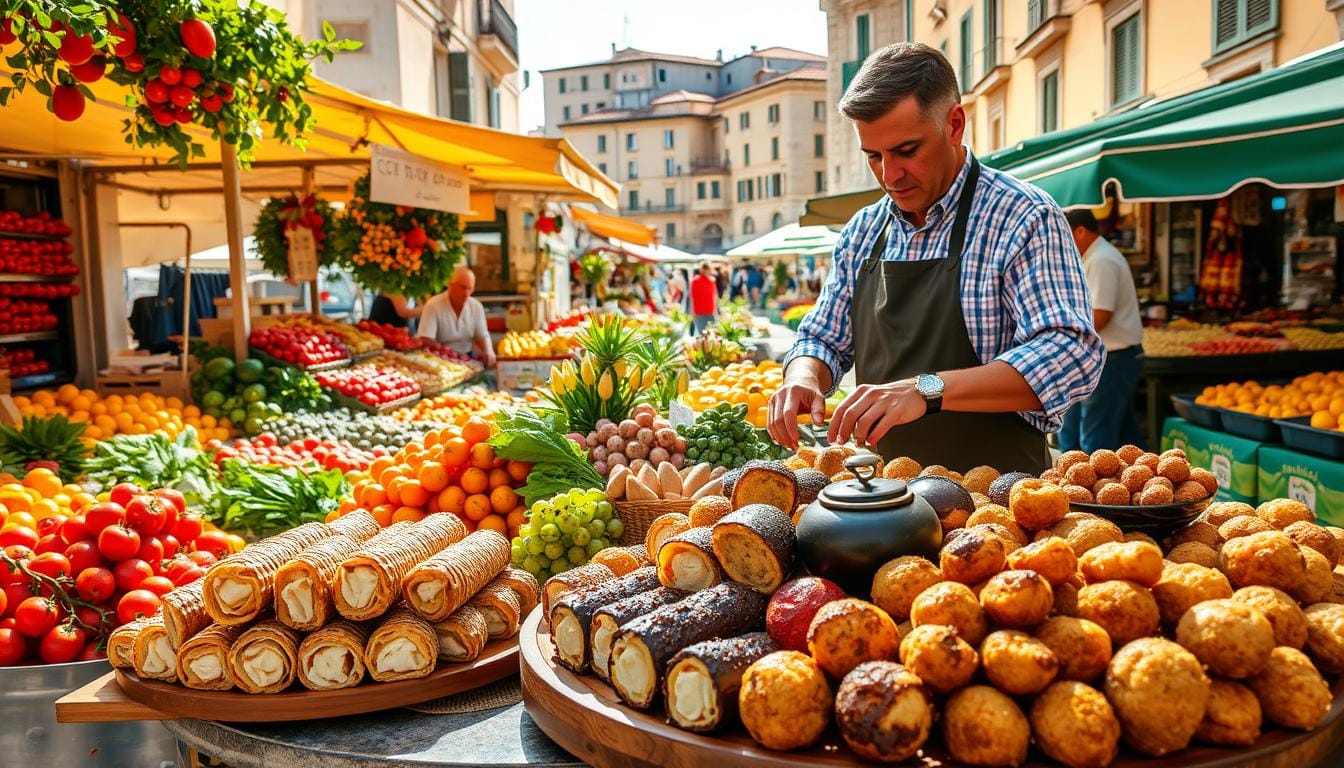What to Eat in Palermo and Catania 2025?: A Guide to Local Sicilian Delicacies
What to Eat in Palermo and Catania 2025?Imagine biting into a golden arancino as you stroll through bustling markets, the crunch giving way to saffron-infused rice and molten cheese. This isn’t just a snack—it’s a bite of history. Sicily’s flavors tell stories of Arab spice traders, Norman kings, and generations of families perfecting recipes in sunlit kitchens. If your idea of travel revolves around unforgettable meals, this guide is your passport to the soul of southern Italy.
In 2025, the vibrant cities of Palermo and Catania remain guardians of the island’s culinary legacy. From street vendors serving crispy panelle to trattorias dishing up swordfish stews, every meal reflects a cultural mosaic. You’ll taste the Mediterranean in olive oil-drenched caponata and feel North Africa’s influence in citrus-kissed couscous. This isn’t just about eating—it’s about savoring a way of life.
Our guide dives deep into must-try dishes, hidden markets, and seasonal specialties. We’ve crafted a curated list to help you navigate food stalls and fine dining alike. Whether you’re hunting for the perfect cannoli or seeking sunset dinners with Mount Etna views, we’ll show you how to turn every bite into a memory.
Table of Contents
Key Takeaways
- Sicilian cuisine blends Arab, Norman, and Mediterranean flavors for a unique culinary identity.
- Street food like arancini and panelle offers affordable, authentic taste experiences.
- Seasonal ingredients and family recipes shape the island’s evolving food scene.
- Historic markets in both cities provide immersive cultural and gastronomic adventures.
- 2025 brings new twists to traditional dishes while preserving centuries-old techniques.
Exploring the Rich Culinary Heritage of Sicily
Picture this: a 12th-century Sicilian kitchen where Arab cooks grind saffron while Norman nobles demand hearty meat pies. This clash of cultures didn’t just shape wars—it forged a culinary tradition that still thrills taste buds today. Every bite here whispers stories of conquerors who became neighbors.
Historical Influences and Cultural Fusion
Arab traders brought ingredients that rewrote Sicily’s flavor map. Rice, citrus, and spices like cinnamon transformed simple meals into layered feasts. One 10th-century cookbook notes:
“A skilled chef balances sweet dates with sharp vinegar—a dance of opposites.”
These flavors merged with Norman love for roasted meats and dairy, creating dishes likecaponata(eggplant stew) andcassata(ricotta cake).
Evolution from Arab to Norman Traditions
By the 13th century, Sicily’s kitchens buzzed with innovation. Arab sugar met Norman almonds in frutta martorana—marzipan fruits still sold at festivals. The table below shows how key ingredients evolved:
| Arab Influence | Norman Influence | Modern Dish |
|---|---|---|
| Saffron, citrus | Hard cheeses, pork | Arancini (stuffed rice balls) |
| Cinnamon, almonds | Wheat-based pastries | Cassata Siciliana |
| Rosewater, couscous | Olive oil preservation | Pasta con le sarde |
Today, family-run trattorias guard these recipes like treasure. As one chef told me, “We don’t own these dishes—we borrow them from history.” From market stalls to Michelin plates, Sicily’s cuisine remains a delicious paradox: ancient yet ever-changing.
What to Eat in Palermo and Catania?Discovering Specialties
Ever wondered why a simple rice ball sparks passionate debates? The arancino/arancina naming feud reveals Sicily’s culinary pride. Locals argue over gender endings and shapes—round vs. teardrop—while visitors savor the crispy exterior hiding saffron rice and molten cheese.
Iconic Dishes and Their Origins
Pasta alla Norma tells a story through its ingredients. Named for Bellini’s opera heroine, this dish combines fried eggplant, tomato sauce, and salted ricotta—a tribute to Catania’s volcanic soil. Street vendors elevate humble ingredients too: pani câ meusa (spleen sandwich) uses horse meat, a protein choice dating to Arab rule.
Local Twists in Traditional Recipes
Modern chefs reinvent classics without losing their soul. Some swap horse meat for slow-cooked lamb in street food, while others stuff arancini with pistachio pesto. « Our ricotta isn’t just filling—it’s the star, » says a third-generation pastry chef, dusting cannoli with crushed pistachios.
Even pasta gets creative updates. Twisted busiate noodles now cradle seafood in Palermo, while Catania’s trattorias add chili to swordfish recipes. These variations honor tradition while tempting adventurous foodies.
What to Eat in Palermo and Catania?The Best Street Food Finds in Sicily
The sizzle of olive oil hitting a hot skillet signals your entry into Sicily’s living food theater. Every corner hums with vendors flipping golden arancini and layering chickpea fritters onto crusty rolls. This isn’t just eating—it’s front-row seating to a centuries-old culinary performance.
Arancini, Panelle, and Pani câ meusa
Bite into a freshly fried arancino, and you’ll understand why locals debate its name. The crisp shell cracks to reveal saffron-stained rice hugging molten ragù. Street cooks shape these orbs by hand, stuffing them with peas or pistachio cream. “Each one’s a portable feast,” laughs a vendor dusting crumbs from his apron.
Nearby, panelle—chickpea flour fritters—crisp in bubbling oil. Served on sesame-studded bread, they’re Sicily’s answer to fast food. But the real adventure? Pani câ meusa. This brazen snack piles veal spleen and lung onto a roll, a recipe born from Arab butchers using every meat bit. The tangy caciocavallo cheese cuts through the richness perfectly.
What makes these street food gems unforgettable? It’s the details: the audible crunch of a perfect fry, the way steam escapes when you tear open a sandwich. From dawn till midnight, Sicily’s streets serve edible history—one delicious dish at a time.
What to Eat in Palermo and Catania?Pasta, Seafood, and Savory Delights
Your fork twirls through ribbons of pasta coated in vibrant tomato sauce, the aroma of fried eggplant mingling with fresh basil. This is Sicily’s pasta culture—where every dish carries centuries of tradition and a dash of drama.

Pasta alla Norma and Pasta con le sarde
Pasta alla norma earned its name from an 1800s opera composer’s enthusiastic comparison to Bellini’s masterpiece. The dish balances fried eggplant with sweet tomatoes, salty cheese, and aromatic basil. “It’s like a symphony in your mouth,” says a Catania chef while drizzling olive oil over twisted pasta alla busiate.
Equally historic, pasta con le sarde showcases Sicily’s love for seafood. Fresh sardines swim in a sauce of wild fennel, pine nuts, and raisins—a recipe tracing back to Arab sailors. The onion-based foundation simmers slowly, giving time for flavors to deepen into umami richness.
Fresh Seafood and Local Market Finds
Morning markets display today’s catch: ruby-red prawns, silvery anchovies, and plump sea urchins. Vendors toss pasta alla vongole with clams harvested that dawn, while grill masters char octopus tentacles over olive wood coals.
Modern twists honor tradition. One cook stuffs squid with pasta crumbs and lemon zest, another layers tomatoes over swordfish carpaccio. As the sun dips, families gather around plates of pasta alla norma, where every bite whispers stories of volcanic soil and opera-inspired creativity.
What to Eat in Palermo and Catania?Sweets and Desserts: Classic Sicilian Treats
Crackling pastry shells give way to velvety ricotta cream—your first bite of a Sicilian cannolo isn’t just dessert, it’s edible archaeology. These sweets preserve techniques from Arab sugar sculptors and Norman dairy masters, transformed through centuries of culinary innovation.
Cannolo, Cassata, and Marbled Pastries
Creating the perfect cannolo demands precision. Bakers fry paper-thin dough into golden tubes, filling them with sweetened ricotta seconds before serving to maintain crunch. “The shell must shatter like glass,” explains a third-generation pastry chef, dusting ends with crushed pistachio.
| Sweet | Key Ingredients | Texture | Occasion |
|---|---|---|---|
| Cannolo | Ricotta, candied citrus | Crispy-creamy | Daily indulgence |
| Cassata | Almond paste, marzipan | Dense-moist | Weddings |
| Marteddus | Pistachio, honey | Crumbly-chewy | Festivals |
Granita and Brioche for a Sweet Refreshment
Dawn in Sicily means granita—semi-frozen blends of lemon or coffee poured over warm brioche. This dessert traces back to Arab snow traders who preserved mountain ice with fruit syrups. Modern versions feature Bronte pistachio paste swirled into velvety layers.
Bakers age ricotta for weeks to deepen flavors in cassata cakes. The result? A marbled masterpiece where sweet cheese balances almond crust. Every bite carries the weight of history—and the lightness of Sicily’s endless creativity.
Wine, Beverages, and Local Pairings
What if your glass of wine could taste like sunbaked Sicilian hillsides? The island’s drink culture transforms meals into multisensory journeys. From amber-hued Marsala to honeyed Passito di Pantelleria, each sip carries whispers of volcanic soil and sea breezes.

Marsala, Passito di Pantelleria, and Local Wines
British merchants first aged Marsala in oak barrels in the 1700s. Today, this fortified wine pairs perfectly with sharp pecorino or almond-studded food. Passito di Pantelleria’s sun-dried grapes create a dessert wine that dances with ricotta-filled pastries.
| Wine | Region | Flavor Profile | Perfect Pairing |
|---|---|---|---|
| Marsala | Western Sicily | Nutty, caramel | Aged cheeses |
| Passito | Pantelleria | Apricot, honey | Cannoli |
| Etna Rosso | Volcanic slopes | Cherry, herbs | Grilled swordfish |
Innovative Pistachio Pesto and Refreshing Drinks
Modern mixologists crush Bronte pistachios into pesto for citrusy cocktails. “We’re bridging cuisine eras,” says a Trapani bartender shaking basil-infused gin with pistachio syrup. Even classic lemon granita gets updates—some vendors layer it with espresso or blood orange.
The variety astonishes: crisp white wines from coastal vineyards, herbal liqueurs from mountain monasteries. Each drink mirrors its city’s rhythm—brisk Palermo aperitivos, Catania’s slow-sipped digestivos. As you clink glasses overlooking ancient markets, you’ll taste Sicily’s liquid soul.
What to Eat in Palermo and Catania?: A Culinary City Comparison
Morning light hits these cities differently. In one, vendors arrange blood oranges like stained glass beneath Norman arches. In the other, fishmongers shout over lava-stone counters as Mount Etna looms. Your trip hinges on whether you crave labyrinthine history or volcanic energy.
Street Markets and Iconic Food Spots
Palermo’s Ballarò Market unfolds like a 10th-century spice bazaar reborn. You’ll walk past stalls selling sfincione (Sicilian pizza) while butchers carve horse meat for pani câ meusa. The air hums with Arabic-inflected haggling—a taste of the island’s layered past.
Catania’s Pescheria Market feels more theatrical. Vendors slam octopus on marble slabs near Etna’s shadow. Here, your day starts with granita in a brioche pocket, chased by charcoal-grilled swordfish skewers. The way ingredients are presented—raw, smoky, briny—mirrors the city’s untamed spirit.
Vibrant Nightlife and Daytime Food Tours
As dusk falls, differences sharpen. Palermo’s evenings unfold in candlelit courtyards with cannoli and sweet Marsala. Daytime food tours here prioritize hidden places: Byzantine chapels turned pastry shops, Arab-norman palazzos serving almond milk.
Catania buzzes after dark. Bars near the fish market shake seltz cocktails with pistachio liqueur, while late-night arancini stands fuel dance-floor dashes. Morning walks here might include trekking Etna’s vineyards before a rustic farm lunch.
| Market Vibes | Signature Bite | Evening Energy | |
|---|---|---|---|
| Western Hub | Historical mosaic | Spleen sandwich | Leisurely feasts |
| Eastern Hub | Volcanic theatrics | Lemon granita | Electric buzz |
Choose the western hub for a trip steeped in layered history. Opt for the east if you want meals charged with geothermal energy. Either city delivers unforgettable experiences—one whispers through ancient alleyways, the other roars like an erupting volcano.
Conclusion
Your culinary journey through Sicily’s vibrant cities ends where it began—with flavor. Each dish here carries centuries of layered history, from Arab-spiced street snacks to Norman-inspired seafood feasts. Whether you’re savoring crispy arancini in a sunlit piazza or sipping volcanic wines under starry skies, every meal becomes a cultural compass.
The western city enchants with labyrinthine markets where recipes whisper of Byzantine rulers. Meanwhile, the eastern hub thrums with energy—its fish stalls and pastry shops mirroring Mount Etna’s fiery spirit. Together, they showcase Sicily’s genius for blending tradition with bold innovation.
Ready to taste history? Pack your appetite and compare these iconic destinations firsthand. Let swordfish carpaccio teach you about coastal tides, or let cannoli shells crackle stories of medieval kitchens. From dawn markets to midnight espresso stops, every bite tells a story worth discovering.
Start mapping your 2025 Sicilian food adventure today. The cities await—with open kitchens and flavors that outlast empires.

